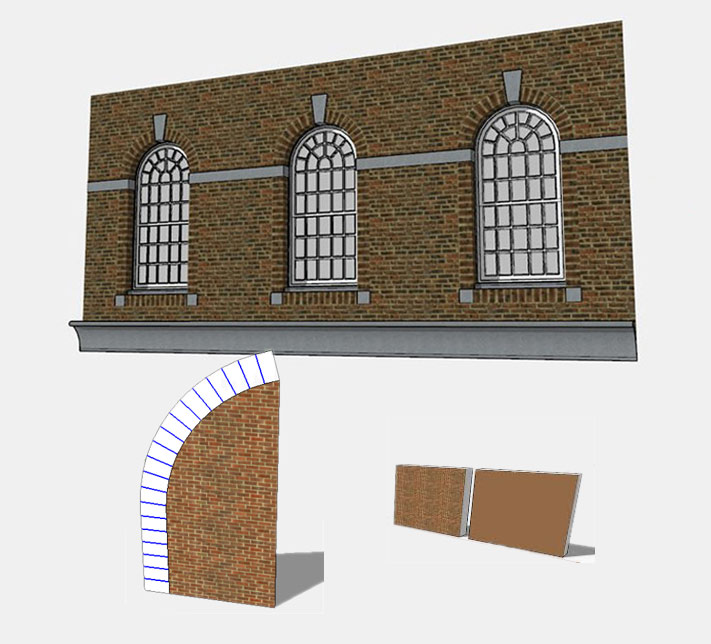
Fredo’s ThruPaint is used to texture an Arch using its QuadMesh UV feature and this technique is particularly useful for Architectural models which reflect the real world construction.
SketchUp is full of tools and extensions, all these extensions are found in the Extension Warehouse of SketchUp. FredoTools groups have a number of standalone plugins and come as a single package. It reduces the footprint on SketchUp and avoids individual installation of each plugin in it.
In this article, we are going to discuss about the method of using Fredo’s ThruPaint to texture an arch using its QuadMesh UV feature. This technique is only useful for Architectural models that reflect the real world construction using only a texture.
ThruPaint is a plugin for SketchUp that expands the native SU Paint tool with some functions like painting across the boundaries of components and groups, control of the faces and face side, texturing with continuity and texturing edition. It can be found in SketchUcation.
- First things first: But at first, users need to install both FredoTools 2.9 and LibFredo 6.9 into SketchUp from SketchUp’s Extension Store directly. After installing them, users can access ThruPaint via Tools > FredoTools > ThruPaint or via FredoTools toolbar. For adding a dedicated ThruPaint icon to SketchUp users need to go to Tools > FredoTools > Default Parameters and under the option “Icons Visible in the Toolbar” they can select ThruPaint option. It will set the icon on SketchUp starting window so user can use it directly from there.
- The topology needed to properly texture in SketchUp: While beginning the work, user will need the geometry to be compliment with ThruPaint QuadMesh UV method. Every face of the arch must be a quad for ThruPaint for applying the texture in a right way.
- Setting ThruPaint to paint QuadMesh UVs: After activating ThruPaint the on screen options need to be set for painting the mesh correctly. If users hover over a face in SketchUp, they can see ThruPaint highlight one edge Green and the other Red, it is very important as this is related to the orientation of the texture.
- Painting and editing textures with ThruPaint: This extension is used to paint the texture and the option ‘All Connected Faces’ is selected so, ThruPaint will align the texture correctly. If manipulating the texture is needed further then users can click the surface again to enter Visual Edit mode. The Visual Editor of ThruPaint allows scaling, rotating and translating textures interactively in SketchUp by dragging tool for SketchUp on the right handle.
Finally it can be said from the upper discussion that ThruPaint is a wonderful texture mapping tool for SketchUp which is also easy to use.
Source: www.sketchucation.com

- Cover Story
-
 SketchUp Can Help You Win Interior..
SketchUp Can Help You Win Interior.. -
 Best Laptops for SketchUp
Best Laptops for SketchUp -
 How to Resize Textures and Materials..
How to Resize Textures and Materials.. -
 Discovering SketchUp 2020
Discovering SketchUp 2020 -
 Line Rendering with SketchUp and VRay
Line Rendering with SketchUp and VRay -
 Pushing The Boundary with architectural
Pushing The Boundary with architectural -
 Trimble Visiting Professionals Program
Trimble Visiting Professionals Program -
 Diagonal Tile Planning in SketchUp
Diagonal Tile Planning in SketchUp -
 Highlights of some amazing 3D Printed
Highlights of some amazing 3D Printed -
 Review of a new SketchUp Guide
Review of a new SketchUp Guide
- Sketchup Resources
-
 SKP for iphone/ipad
SKP for iphone/ipad -
 SKP for terrain modeling
SKP for terrain modeling -
 Pool Water In Vray Sketchup
Pool Water In Vray Sketchup -
 Rendering Optimization In Vray Sketchup
Rendering Optimization In Vray Sketchup -
 Background Modification In sketchup
Background Modification In sketchup -
 Grass Making with sketchup fur plugin
Grass Making with sketchup fur plugin -
 Landscape designing in Sketchup
Landscape designing in Sketchup -
 Apply styles with sketchup
Apply styles with sketchup -
 Bedroom Making with sketchup
Bedroom Making with sketchup -
 Review of Rendering Software
Review of Rendering Software -
 Enhancing rendering for 3d modeling
Enhancing rendering for 3d modeling -
 The combination of sketchup
The combination of sketchup -
 Exterior Night Scene rendering with vray
Exterior Night Scene rendering with vray





